Essential Meat Cooking Temperatures Guide
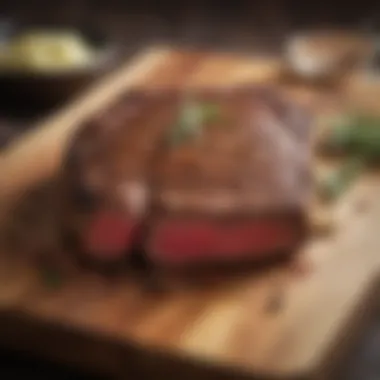
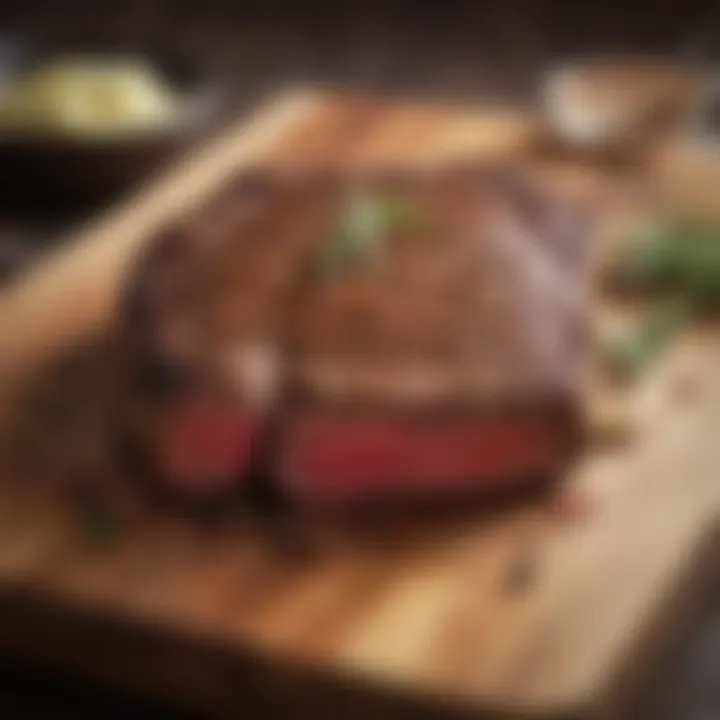
Intro
Cooking meat to the proper temperature is both an art and a science. For many enthusiasts, achieving the perfect sear or a tender roast is as satisfying as the dish itself. However, the reality of cooking meat safely can often feel like walking a tightrope. Too raw, and you risk foodborne illness; too done, and you might end up with a dry, flavorless meal. It’s essential to strike that balance, and understanding meat cooking temperatures is the foundation of that balance.
In this guide, we will delve into the exact temperatures needed to cook various meats, discuss how to effectively use meat thermometers, and clarify common misconceptions that can lead you astray in the kitchen. We aim to equip you with the knowledge that not only ensures safety but enhances flavor and texture in your culinary endeavors.
By the end of this journey, whether you’re grilling a steak on a summer evening or preparing a holiday roast, you’ll feel confident in your ability to reach that sweet spot of doneness, understanding what each temperature means for your dish.
Let’s unravel the threads of meat cooking temperatures, starting with the fundamental concepts before moving into the specifics.
Understanding the Importance of Cooking Meat
Getting a handle on meat cooking might be simpler than it looks. It's not just about slapping a piece of chicken on the grill and hoping for the best. Properly cooking meat can make the difference between a delightful meal and an unpleasant one. Not only does cooking meat correctly enhance flavors, but it also plays a pivotal role in ensuring safety. When we talk about cooking meat, we aren't just referring to aesthetics; it's a balance of art and science, where the temperature ends up being the crucial element that we should not overlook.
Culinary Safety
Risk of foodborne illnesses
One cannot ignore the ugly reality of foodborne illnesses lurking in undercooked meat. Things like Salmonella from poultry or E. coli from beef may not be household names to many, but they illustrate a very real concern. These nasty bugs can lead to symptoms ranging from mild stomach upset to serious health problems. Thus, understanding the risks forms the backbone of meat cooking safety. A key thing to remember is that improper cooking can convert a meal into a potential health hazard.
The unique feature of this risk sits heavily on the idea that many people underestimate the necessity of cooking meat to the right internal temperature. Ignoring this may seem like a small oversight, but it can have pretty unpleasant consequences. In this way, knowing proper cooking temperatures isn’t just helpful; it's downright essential to keep food - and family - safe.
Importance of proper cooking
Consistency in proper cooking can really save the day when it comes to maintaining safety while ensuring a delicious experience. Cooking meat to the recommended internal temperatures can get rid of those harmful bacteria, but this also opens up a world of flavor. When you think about it, cooking meat correctly is both a science and a culinary art form. Having clear guidelines on cooking temperatures helps no one guess when it comes to doneness; it creates that baseline, ensuring safety and flavor are well within reach.
A unique aspect of this focus is how achieving proper temperatures affects not just safety, but also the overall quality of the meat. Think about juicy steaks or succulent roast chicken—those are all a result of correctly managing cooking temperatures. If you trot out meals properly cooked to temperature, you’ll find they shine on the plate. Conversely, erratic temperatures either yield dry, flavorless meat or undercooked dishes that are food poison waiting to happen.
Flavor Development
Maillard reaction
Switching gears a tad, let’s talk flavor. One term that often floats around kitchens is the Maillard reaction. It's a complex thing, but fundamentally, it's about that golden-brown crust you see on properly cooked meat. This wondrous chemical reaction occurs when amino acids and reducing sugars react under heat, resulting in those rich flavors we all crave.
The magic of the Maillard reaction creates depth and complexity in meats that is simply unmatched. A juicy steak with that perfectly scored crust? That’s what we’re aiming for. The beauty lies in the fact that with the right cooking temperatures, you can stimulate this reaction, creating satisfying caramelized textures that tickle the taste buds. With time and temperature, meats go from flavorless to fabulous, making this concept a cornerstone of detailed cooking techniques.
Impact of temperature on texture
On the flip side, let's consider how temperature affects the texture of the meat. Overcooked meat can turn into a tough, rubbery disappointment, while perfect cooking leads to tender, melt-in-the-mouth bites. Understanding the relationship between heat and texture is vital for any cook who seeks to master the art of meat cooking. Each type of meat has its own ideal cooking temperatures which are essential for achieving desired texture.
A quick example, think about beef brisket. This cut becomes tender only when it's cooked low and slow; if someone cranks up the heat, not only will they lose the chance to enjoy its rich flavor, but they’ll end up with a piece that's hard enough to toss at a wall!
- Temperature is key: Low temperatures soften tough cuts while high ones will dry them out.
- Right doneness is your friend: It's a balancing act of finding that sweet spot where meat is juicy yet firm.
Through understanding these elements, the journey towards perfecting meat cooking will become more than just another kitchen task; it's an invitation to explore flavors and textures that make meals memorable.
"Cooking meat properly is not just a skill; it's an experience that transforms a meal into a celebration."
Meat Types and Their Cooking Temperatures
Understanding the cooking temperatures for various types of meat is crucial not only for safety but also to achieve that perfect bite. Each meat type requires its own specific temperature guidelines to ensure it's safe to eat and tastes its best. Knowing these temperatures also helps avoid ruining a potentially great meal by over- or under-cooking.
When discussing meat cooking temperatures, it’s important to focus on the unique characteristics of each type. You step into the kitchen armed with this knowledge and can confidently create culinary masterpieces or a homemade feast worthy of compliment.
Chicken and Poultry
Recommended internal temperatures
Chicken and poultry meat should reach an internal temperature of 165°F (74°C). This guideline is not just a number; it is a shield against foodborne illnesses that could ruin your evening. The reason 165°F is emphasized is that it ensures any harmful bacteria are eliminated.
A common misconception about chicken is that it must always be cooked until the meat is dry and white. In fact, achieving that magic number without sacrificing moisture is the goal. The cooking method, whether roasting, grilling, or poaching, can influence how well the meat retains its juices. Employing a meat thermometer ensures you do not overdo it, and prevents serving meat that is undercooked.
Signs of doneness
Besides temperature, other signs can indicate whether chicken is done. The meat should be opaque, the juices should run clear when pierced, and the texture should be firm. However, these signs, while helpful, can sometimes be deceptive.
A well-cooked chicken breast can still appear slightly pink near the bones, which can lead to anxiety about serving. Relying solely on these visual cues can be a slippery slope; that’s why having specific temperature goals is a good idea. So, when cooking poultry, trusting temperature readings is the most reliable method.
Beef Cuts
Steaks versus roasts
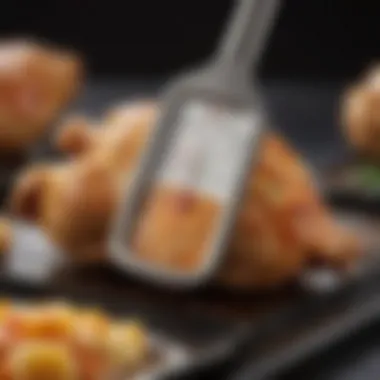
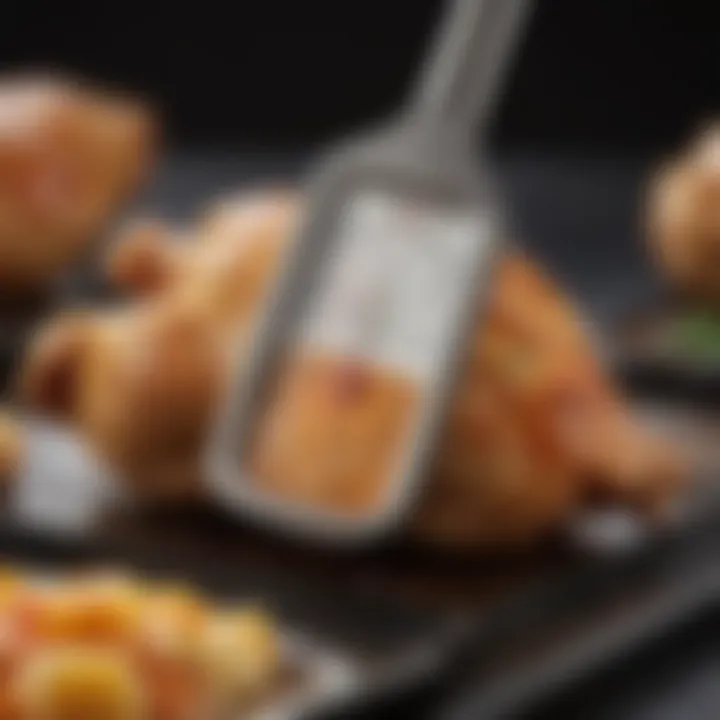
When it comes to beef, there is a world of difference between cuts meant for grilling, like steaks, and those suitable for slow cooking, like roasts. Steaks typically benefit from quick, high-temperature methods, whereas roasts do better with lower, slower cooking processes to ensure tenderness.
Steaks are best cooked to anywhere between 130°F (54°C) for medium-rare and 160°F (71°C) for well done, while larger cuts might need to hit a higher temperature for safety, around 145°F (63°C). This along with time will ensure even cooking throughout while keeping juices intact, leading to that melt-in-your-mouth experience.
Desired doneness levels
Desired doneness levels for beef range from rare to well done, and understanding that spectrum can make or break your meal. Rare beef is a deep red, while well done resembles more of a brown color. Selecting your level depends on personal preference, and knowing how to achieve that through specific temperatures is crucial.
For instance, medium-rare is typically favored for its tenderness and flavor preservation. On the other hand, cooking it well done removes moisture and flavor, which some diners might not prefer. With steaks, there is no one-size-fits-all; even slight temperature adjustments can lead to varying textures and taste experiences.
Pork Varieties
Safe minimum temperatures
For pork, safety is paramount. The USDA’s safe minimum temperature for pork is 145°F (63°C), along with a three-minute resting period. Many people have a fear of undercooked pork, often due to the misconception of it being akin to chicken. Truth be told, fresh pork can be pretty safe if cooked to the right temperature, dispelling the myth that pork must be overcooked to be safe.
A delicious medium pork chop allows for a bit more flavor retention compared to a well-done version, and resting allows flavors to redistribute.
Medium rare versus well done
The debate continues on the merits of medium-rare versus well-done pork. Medium-rare pork retains a delicate taste and provides a juicy texture, whereas well-done pork can often end up dry. Diners have varying opinions on this, and preferences change based on cultural influences as well.
Understanding the guideline of 145°F (63°C) gives you the option to cook it to each diner’s liking, giving control over the final result while remaining entirely safe to consume, paving the way for delightful meals.
Lamb and Game
Cooking guidelines for lamb
For lamb, the recommended internal temperature is around 145°F (63°C) for medium. Unlike other meats, lamb is often associated with robust flavors, and cooking it at the right temperature allows those flavors to shine through.
With cuts like leg or racks of lamb, shorter cooking times with high heat can yield beautifully charred crusts with tender meat inside. However, don’t be fooled into thinking it’s all about heat; knowing when to take it off the heat and allowing it to rest is just as crucial for flavor enhancement!
Temperature considerations for game meat
Game meat can be a bit of a wild card, literally. The general rule of thumb varies but often hovers around 160°F (71°C) for safety. Game like venison can still shine in flavor even when cooked to medium. The key with game meat lies in understanding the freshness and specific breed’s characteristics, as each type may require slightly adjusted cooking practices to achieve the best flavor.
Using temperature to understand when to stop cooking can help retain moisture and flavor, thus elevating the eating experience.
By mastering the cooking temperatures for different meats, you set the stage for culinary success. It's not just about avoiding foodborne illnesses; it's about crafting a meal that pleases the palate and delights the senses.
Understanding Doneness Levels
The realm of cooking meat involves not just preparing a meal, but mastering the nuances of doneness. Knowing what each doneness level indicates can be the difference between a disappointingly dry steak and one that makes you want to sing its praises. Understanding these levels is paramount for both flavor and texture. A perfectly cooked piece of meat not only satisfies the palate but also exudes confidence on the plate.
Rare to Well Done
Defining each doneness level
When we talk about doneness, we are essentially discussing the degree to which meat is cooked. This has several levels: rare, medium rare, medium, medium well, and well done. Each one has its own characteristics. For example:
- Rare: Typically cooked to an internal temperature of about 125°F (52°C). It’s red, cool in the center, and has a soft, tender texture.
- Medium Rare: Reigning as a favorite among enthusiasts, this level reaches around 130-135°F (54-57°C). It offers a warm, red center and encourages juices to flow with every bite.
- Medium: This one sits at approximately 140-145°F (60-63°C). It’s a happy medium that balances flavors well yet still retains some juiciness.
- Medium Well: Getting a bit firmer here—about 150-155°F (66-68°C) leaves little moisture behind. The pink is faded but still present.
- Well Done: No red in sight, firmly cooked above 160°F (71°C). While often deemed safe, it can risk a more rubbery texture.
Each level has its advantages, speaking to personal preferences and culinary contexts. The key takeaway remains: knowing these distinctions not only elevates your cooking skills but caters to your diners’ tastes, effortlessly transforming an ordinary meal into an extraordinary one.
Preferred cooking methods for each level
Now that we know how to define each level, let’s dive into cooking methods that can make or break these doneness levels.
- Rare & Medium Rare:
For these, high-heat, quick cooking methods work wonders. Think searing on a cast-iron skillet or grilling over direct heat. A rapid cook preserves that luscious juiciness while creating an appealing crust. - Medium:
Medium doneness can be achieved through various methods such as pan-searing, baking, or even sous-vide, allowing for more control over the cooking process. This versatility ensures an evenly cooked piece of meat that isn't dry. - Medium Well & Well Done:
For the latter doneness levels, slow and steady wins the race. Roasting or braising allows for thorough cooking while maintaining as much moisture as possible. But don’t just leave it; check in often. These methods can easily go from perfection to shoe leather if unattended.
Knowing which method to apply is a game changer in the kitchen—after all, nothing beats a perfectly cooked meal that has your guests raving about their experience.
Resting Periods
Why resting matters
Resting meat after cooking is often an overlooked aspect. Many chefs and home cooks alike rush through this step, eager to dig in. But hold your horses, as resting allows juices to redistribute throughout the meat. When cooked, the proteins tighten and push out moisture; resting reverses this to a degree by letting them relax.
"Every time you skip resting, you might as well pour a bit of flavor down the drain."
It's beneficial to let meats rest for about 5 to 10 minutes, depending on size. This not only helps with juiciness but also allows flavors to meld together for a rounded taste.
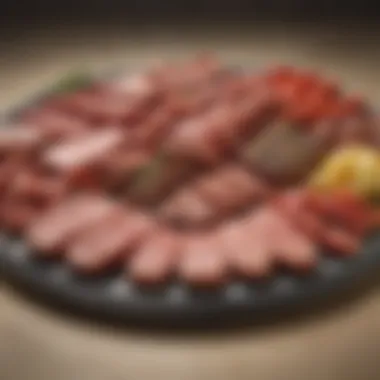
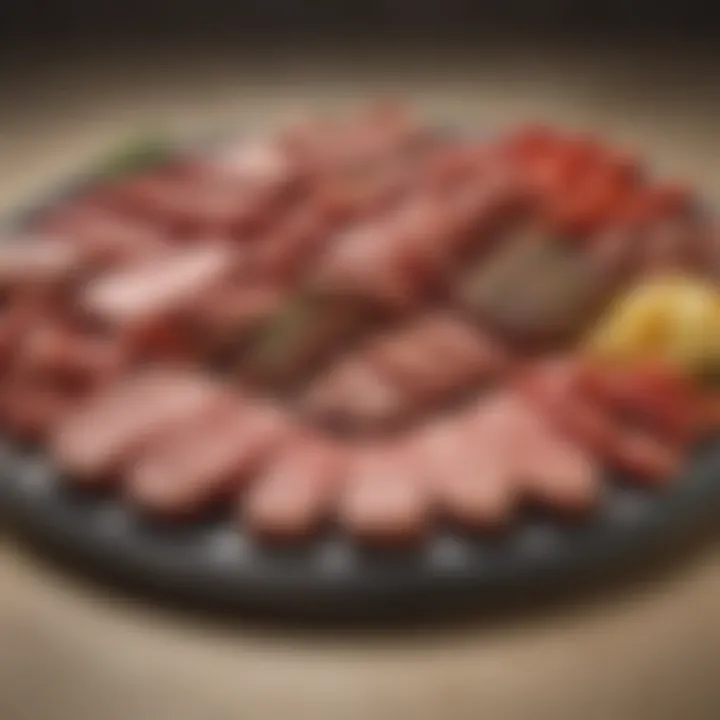
Effects on juiciness and flavor
The effects of resting are nowhere more evident than in the juiciness and flavor of the meat. A steak that has rested will have a more uniform moisture level, preventing those disappointing dry spots. Imagine cutting into a roast that releases a cascade of savory juices. It’s an experience, not just a meal.
When meat doesn't rest, you risk losing about 10-20% of its juices as it cools down quickly on the plate. The unique feature here is that resting is as crucial as the cooking itself. A steak could be perfectly skilled, but serve it too soon and you lose much of what made it great. Ultimately, understanding this simple yet often neglected practice can boost your culinary prowess significantly.
Essential Tools for Accurate Cooking
Cooking meat isn’t just about throwing it on the heat and hoping for the best. Understanding the right tools to aid in achieving that perfect cook is vital. Being equipped with the right instruments helps ensure both safety and flavor. Knowing the significance of accurate cooking tools can take your culinary skills from meh to marvelous.
Thermometers Explained
Types of meat thermometers
When it comes to meat thermometers, the market offers a variety including instant-read, dial, and probe thermometers. Each type serves a unique purpose that can greatly influence your cooking outcomes.
- Instant-read thermometers are quick, showing temperatures in seconds, which is excellent for those who want immediate results.
- Dial thermometers tend to be less expensive but can take longer to register temperatures. They’re generally considered good for roasting.
- Probe thermometers allow you to monitor cooking over long periods, suitable for slow cooking or large cuts of meat.
Each type has its quirks, but they all focus on one main goal — ensuring your meat reaches the right temperature. Consider the instant-read thermometer for quick checks without opening the oven. Its speed can help retain essential heat, optimizing your dish.
How to use a thermometer effectively
Using a thermometer is all about placement and technique. The right spot for inserting the thermometer is in the thickest part of the meat, avoiding bones or fat, as they can provide inaccurate readings.
- Insert it correctly: Ensure it’s not touching bone, which can confuse the reading.
- Check the temperature while cooking: Regular checks will help keep track without losing heat.
- Know the target temp: Familiarize yourself with the recommended temperatures for different meats; a guide is handy.
A thermometer should become a constant companion in your cooking journey. Its accuracy can save you from undercooking or ruining a meal, allowing you to pull meats off the heat at just the right time.
Other Cooking Aids
Grill and stovetop techniques
Grilling and stovetop cooking each bring a unique aspect to meat preparation. These methods offer great control over the cooking temperature that can enhance flavors.
- Grilling: Direct heat from below gives a charred, smoky flavor, essential for the barbecue lover.
- Stovetop techniques: The ability to manage temperature on your stovetop, whether on high or low, allows you the flexibility needed for different cuts of meat.
Grilling can produce those desirable grill marks, while stovetop cooking can achieve a perfect sear. Each method has its stars and pitfalls, and incorporating both in your repertoire can yield delicious results.
Utilizing sous-vide for precision
Sous-vide, translating to "under vacuum," has been a game-changer for many chefs and home-cooks alike. This method involves cooking food slowly in a water bath, allowing precise temperature control that results in consistently tender meats.
- Consistent results: You can rely on this technique to achieve a specific doneness level without guesswork.
- Infused flavors: Cooking meat in a vacuum-sealed bag can intensify flavors due to the concentration of juices.
However, sous-vide requires various equipment like a vacuum sealer or immersion circulator, which could be seen as a disadvantage. But for those who crave accuracy and are willing to invest, sous-vide can elevate your cooking experience.
"Understanding the tools of the trade is as important as having the right ingredients. A well-equipped kitchen is a cook’s best friend."
The key to confident meat cooking lies in using the right tools. Armed with thermometers and various cooking techniques, every dish is one step closer to perfection.
Common Misconceptions about Meat Cooking
When it comes to cooking meat, there is often a fair bit of confusion. These common misconceptions can lead to both culinary mishaps and safety concerns. Addressing these myths is essential to foster a better understanding of how to handle and prepare meat properly. Knowing the facts can not only enhance the dining experience but also play a critical role in ensuring food safety. By clearing the air around these myths, cooks of all skill levels will feel more confident in what they’re doing in the kitchen.
Notably, it’s important to separate fact from fiction, as this can lead to greater enjoyment and reduced risk of foodborne illnesses. Let’s dive into specific myths that have permeated cooking culture and examine the truths behind them.
Myths Debunked
Undercooked meat is always unsafe
Many people operate under the assumption that all forms of undercooked meat should be viewed with suspicion. While it’s true that certain meats can pose a risk when not cooked properly, that doesn’t mean that all undercooked meat is unsafe across the board. The key characteristic of this misconception is its blanket generalization. For instance, steak cooked medium-rare might be perfectly acceptable, as quality beef can undergo processes that minimize health risks.
It's also essential to consider the source of the meat in question. High-quality cuts from reputable suppliers may be less likely to harbor dangerous bacteria, allowing for cooking methods that preserve flavor and texture. However, relying solely on the color or juiciness of meat to judge its safety can lead to dangerous decisions.
When it comes to this misconception, a significant advantage of understanding the risks versus benefits is that you get to enjoy more diverse cooking styles. Think of it this way: a well-cooked steak can be a true delight, where the tenderness and taste take center stage. This allows adventurous cooks to explore more nuanced meals, rather than shying away from it altogether.
Color is an indicator of doneness
Another pervasive notion is that the color of the meat can reliably indicate its doneness level. Many believe that if meat looks pink, it is undercooked, while if it’s brown, it’s done. However, the oversimplification involved here is misleading. Color can fluctuate based on various factors—cooking methods, the specific cut of meat, and even the way it was treated prior to cooking.
For example, using a meat thermometer is a much more trustworthy way to gauge doneness than relying on color alone. A steak might be a rosy pink inside yet reach an internal temperature reflecting that it’s quite safe to eat. On the flip side, meat that looks cooked and brown on the outside might still be raw on the inside, particularly with larger cuts or roasts. This misconception limits cooks to a narrow viewpoint, often leading to overcooked meat that’s devoid of flavor and juiciness.
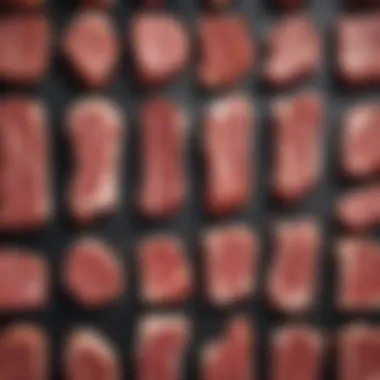
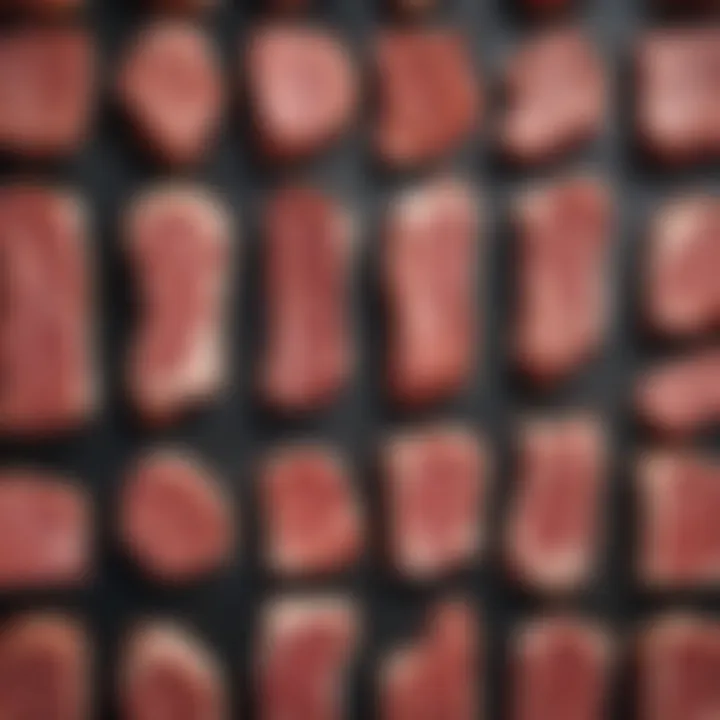
The true measure of meat doneness lies in temperature, not just appearance.
By focusing on temperature instead of color, cooks can create dishes that are both safe and satisfying. Moreover, knowing this can enhance one's culinary creativity, allowing for the preparation of perfectly cooked meals that rise above simplistic judgments based on mere visual cues.
Advanced Techniques for Meat Cooking
In the culinary world, traditional methods can only take you so far. Embracing advanced techniques like sous-vide and smoking can elevate your meat cooking game significantly. These methods not only enhance flavors but also ensure precision that conventional cooking often lacks. With the right approach, these techniques can turn an ordinary meal into a remarkable culinary experience, marrying science and art in the process.
Sous-Vide Cooking
Sous-vide, which translates to "under vacuum" in French, is a method that involves sealing food in a vacuum bag and cooking it at a precise temperature in a water bath. This technique has gained traction among chefs and home cooks alike due to its unique advantages.
Benefits of sous-vide
The primary benefit of sous-vide cooking lies in its ability to achieve consistent temperatures throughout the meat. This eliminates any guesswork and minimizes the chances of overcooking or undercooking. Unlike traditional methods, where the outer layers can easily become dry before the center is done, sous-vide ensures even doneness from edge to edge.
Moreover, the sealed environment helps retain moisture, making steaks exceptionally juicy and tender. It's like giving your meat a warm, cozy hug. The flavors infused during this process are often richer and more pronounced, allowing your culinary creations to truly shine.
Additionally, compared to other methods, sous-vide offers flexibility in cooking times; you don’t have to hover over the stove or grill. Just set it, forget it, and trust that your meat will be ready when you are.
Steps to sous-vide meat
Getting started with sous-vide might seem intimidating, but the steps are simple and straightforward:
- Prep the Meat: Season your cut of meat as desired, then place it into a vacuum bag. Removed as much air as possible to aid in heat conduction.
- Seal the Bag: Use either a vacuum sealer or the water displacement method if you don’t have one (submerge the bag in water to push out the air and seal it tightly).
- Set the Temperature: Preheat your water bath to the desired temperature. For instance, if you’re aiming for medium-rare beef, that would typically be around 130°F (54°C).
- Cook: Submerge the sealed bag in the water bath for the recommended time, which can range from 1 to 48 hours depending on cut and thickness.
- Sear (Optional): Once done, you can give your meat a quick high-heat sear to develop a crust, enhancing texture and flavor.
After these steps, your meat is ready to be served, perfectly cooked and packed with flavor.
Smoking and Grilling
Smoking and grilling are age-old techniques that bring a distinct taste profile to meats. Both methods require focus on temperature control to unlock the full potential of the ingredients, making it a vital part of our cooking knowledge.
Temperature control while smoking
When smoking meat, controlling the temperature is crucial. Unlike grilling, smoking is done at lower temperatures over a longer period, often between 225°F to 250°F (107°C to 121°C). This range allows the meat to absorb the smokey flavors thoroughly while breaking down tough connective tissues.
Control is critical; a slight change in temperature can mean the difference between tender meat and a chewy disaster.
The unique feature of smoking lies in the wood types and how the heat interacts with the meat. This method is an art form, where different woods lend different flavors, such as hickory providing a robust edge and applewood offering a sweeter touch. Balancing temperature and time helps achieve that perfect external bark while keeping the meat moist internally. Maintaining the right temperature over several hours can be a challenge, but the reward is a flavor that’s simply unmatched.
Grilling temperatures for optimal flavor
Grilling is often viewed as more accessible compared to other techniques, yet it’s the temperature control that makes all the difference in flavor. For grilling, temperatures typically range from 400°F to 600°F (204°C to 316°C) for direct heat cooking. This high-heat environment is excellent for creating that delicious sear that locks in juices, enhances flavors, and provides the appealing grill marks all lovers of grilled meat fancy.
The key characteristic of grilling is the quick cooking time; therefore, you should be diligent about monitoring your burner zones and using a thermometer for accurate measurements. Also, pay attention to resting times after grilling; allowing meat to rest for a few minutes is crucial, as it lets juices redistribute, which leads to a more flavorful bite.
End: Mastering Meat Cooking Temperatures
Understanding meat cooking temperatures is not just a matter of preference, it’s a fundamental part of cooking that impacts both safety and flavor. Throughout this article, we’ve journeyed through various types of meat, the science of cooking, and the tools needed to achieve perfection, but why is mastering these temperatures so vital?
First off, anyone who’s ever taken a bite of rubbery chicken or dry steak knows that proper cooking temperatures can make or break a dish. They are the unsung heroes, ensuring that your food is not only safe to eat but also delicious. By grasping the temperatures for different meat types—whether it’s a juicy pork loin or delicate chicken breast—cooks can really elevate their culinary game and offer a delightful experience to anyone at their dinner table.
Another layer to this mastery involves continual learning. Meat cooking is an evolving art. From discovering new techniques like sous-vide to embracing the old-world charm of smoking, understanding cooking temperatures opens doors to all sorts of culinary adventures. Keep your curiosity alive, ask questions, and learn from both success and mistakes.
Summary of Key Points
Safety and enjoyment
Safety should always be at the forefront of any cooking venture. Undercooking can lead to foodborne illnesses, while overcooking can strip away flavors and textures that make meat enjoyable. Historical cooking wisdom often emphasized well-done meats, primarily to ensure safety, but with proper understanding of heat and time, cooks can serve meats that are both safe and succulent.
Key characteristic: The key here is balance. Knowing the right temperatures makes it possible to serve moist, flavorful cuts without risking health.
Unique feature: Emphasizing safety fosters trust. Being knowledgeable about cooking meat ensures that meals can be enjoyed without second-guessing. This knowledge fosters an environment where cooking isn’t just a chore—it transforms into a joyful experience.
Continued learning in cooking
Cooking isn’t a static skill; it’s one that benefits from ongoing exploration and education. Engaging with different cultures, cuisines, and techniques serves to broaden one’s palate and skill set.
Key characteristic: The culinary world is rich with resources, where continuous learning is not just welcomed, it's essential to stay relevant in an age of rapidly evolving tastes.
Unique feature: With every dish prepared, cooks gain insights that refine their methods. Mastering meat cooking temperatures isn’t a one-and-done checklist; it’s a lifelong journey filled with opportunities to discover new flavors, methods, and preferences.
"By understanding the temperatures for various meats, one can transform from an average cook into a culinary maestro."
For more on cooking techniques and the science behind it, you can check this resource.
For lively discussions, consider visiting forums like reddit.com.
Happy cooking!







